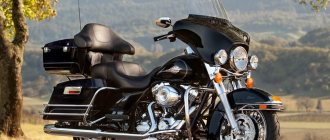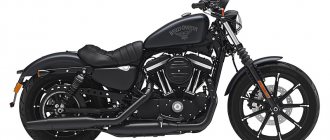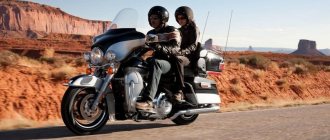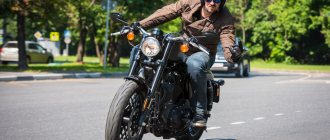Three-wheeled Harley Davidson CVO Tri Glide 2020
Classic trikes like the Harley Davidson Tri Glide seem strange to real seasoned motorcyclists, especially young and vigorous guys. Do you know who likes trikes? Girls of all ages. Shouldn't we be happy that there are more and more female motorcyclists, no matter how many wheels their motorcycles have?
Three-wheeled Harley Davidson
The stability of the three-wheeled design makes trikes an excellent choice for those who lack the confidence to ride a large motorcycle, especially if the ride involves two people.
For example, let’s take you personally in your old age: do you plan to give up motorcycles when you realize that you cannot hold the bike at a traffic light?
Among Harley owners, the oldest category is trike owners. These motorcycles are also great for people with prosthetic legs.
But there is no need to consider trikes as a type of wheelchair with a motorcycle-type steering wheel. Harley Davidson reports that trikes have the highest mileage of all their products, and it turns out that some of the owners of such devices are simple long-distance motorcycle travelers, who like to take a lot of luggage with them, who do not worry about slippery roads and stupid sayings like “two wheels make the difference.” soul, but you’d better buy a car.”
Harley Davidson CVO Tri Glide 2020
History of Harley Davidson trikes
The history of Harley Davidson trikes begins in 1932 with the Servi-Car model, which was produced until 1973. And the recent history of their trikes began with the appearance of the Tri Glide Ultra Classic in 2009. They were partly based on Lehman Trikes, but the Tri Glide chassis was originally designed for riding on three wheels.
Our goal was to create a factory three-wheeled motorcycle, with all the advantages of factory production - sophisticated design, quality of finish and availability of service and spare parts,” said a Harley representative.
The Harley Davidson line of trikes was expanded in 2015 with the introduction of the more minimalist Freewheeler. But today's story is about another, the most sophisticated trike from the Harley Davidson line, in the premium trim and coloring inherent in the Custom Vehicle Operations series (Harley Davidson's subsidiary brand for limited editions of super-premium motorcycles)
What are the differences between Harley-Davidson motorcycle models?
Are you knowledgeable about Harley-Davidson models? If not, then I will teach you. Experts, keep quiet! This is not for you. I intentionally avoid numbers, indexes, technical terms and details. Keep it simple, short and, I hope, clear!
With all the apparent diversity of all kinds of Harleys, there are not so many unique Harley-Davidson models. All of them are divided into eight groups. Let's start in order.
1. Harley-Davidson Sportster
The smallest and most affordable motorcycle in the range. It is also, perhaps, the most classic. This line has been produced, scary to say, since 1957! From the name it is clear that this motorcycle was intended as a sports bike. What types of motorcycle racing have Sportsters not participated in? They were raced on asphalt, on a track, and even in mud. It was the Sportster, thanks to its sporting success, that was once recognized as No. 1 in America. A large unit on one of Harley’s signature emblems (you’ve probably seen it at least once) symbolizes the brand’s first place on all kinds of podiums.
This is what a typical modern Sportster looks like. Its design is simple and unpretentious. You could say that the entire motorcycle is built around a large twin-cylinder V-twin engine. I will not burden you with technical details, but will only say that today athletes are produced with “small” (volume 883 cubic centimeters) and large (1200 cm3) engines.
At the moment, there are seven varieties of Sportsters in the Harley-Davidson model range. By and large, it's all the same thing. The only differences are in the external design and body kit. If you are interested, the picture above shows the following modifications (in order): 883 Roadster, Superlow, Forty-Eight, Iron 883, Superlow 1200T and Seventy-Two. The seventh - 1200 Custom - was in the previous photo.
The easiest way to recognize a Sportster on the street is the round speedometer mounted on the handlebars, the oil churn on the right side under the saddle, and the two rear shock absorbers on display. And please never say that a Sportster is a chopper (you should be careful with that term in general) or a cruiser! This is just a compact classic motorcycle, a kind of “entry ticket” to the world of Harley-Davidson. The most, I repeat, modest and accessible, but at the same time, not the most uninteresting! True, in our country, where many things are turned upside down and show-off sometimes plays the main role, Sportsters are considered not particularly prestigious motorcycles and their owners, they say, are not even accepted into some motorcycle clubs.
2. Harley-Davidson Dyna
The second model, or rather a group of models, in the line. According to one version, her name comes from the abbreviated name of the town of Daytona (Florida), famous for the auto and motorcycle racing held there at all times, as well as noisy rallies and parties for fans of all kinds of motorized equipment.
In terms of its dimensions, this motorcycle is not very different from the Sportster, but its engine is larger and more powerful. A characteristic feature: the engine is not fixed in the frame rigidly, but through special elastic elements - silent blocks, and while driving it vibrates and lives its own life. Some say “fights like a bird in a cage.” Due to this, the motorcycle gives the impression of a breathing and quivering living creature. An indescribable feeling, so appreciated by numerous fans of this model!
There are five models in this group today, also, as in the case of the Sportster, differing only in details. I'll name them in order, as they are shown in the picture: Street Bob, Wide Glide, Low Rider, Fat Bob and the long-distance Dyna Switchback. The latter can be recognized by its removable windshield and hard saddlebags. Also, of course, removable.
In general, the main, most characteristic features by which this model can be recognized on the street are the speedometer located on the gas tank and two rear shock absorbers - exactly like the Sportster. Keep in mind: both of these signs must be present for accurate identification! Not sure? Then pay attention also to the characteristic angular battery box attached under the saddle.
But on our roads, motorcycles of this family are still relatively rare. Apparently, most domestic bikers simply haven’t tried them. No wonder! After all, the Dyna is not the most affordable motorcycle from Harley-Davidson, nor the fastest, nor the most pretentious. Due to this, it is not the most prestigious. We have! And, here, “they” have Jax Teller from the TV series Sons of Anarchy riding Dyna. And even the president of the club himself, Clay Morrow... Well, how much cooler is that?
3. Harley-Davidson Softail
Big, heavy motorcycle. Perhaps the most popular in the company’s lineup. My favorite film Wild Hogs (“Real boars” in Russian box office) can almost be considered an advertising video for this model!
The main feature of this model is the classic look with a “dry” frame. Here it is necessary to make a small digression: once upon a time, when the trees were big and the grass was green, motorcycles often did without rear suspension at all. The wheel was attached directly to a rigid (“dry”) frame without any springs or shock absorbers. Can you imagine how every bump on the road reverberated in the rider’s back? In memory of those good old days, when hemorrhoids and all kinds of neuralgic diseases of the spine were inevitable companions of motorcyclists, the modern Harley-Davidson Softail was built.
But, in fact, his “tail” is not hard, but soft. Which is reflected in the title. The “dry” frame is nothing more than decoration here. In fact, the motorcycle has shock absorbers. They are installed horizontally and hidden under the saddle so as to spring the movable rear part of the frame - the pendulum. Due to this, riding such a motorcycle is very comfortable! I can’t help but say a few words about engines. In general, they are the same as on the Dyna family models that I talked about last time. The only differences are that here the engine is rigidly mounted in the frame and, in addition, is equipped with a so-called balancer shaft, which reduces vibrations to an acceptable minimum.
This model year there are only six models in this line. I’ll name them in order, as in the picture: Softail Slim is the simplest and, perhaps, even minimalistic modification. Fat Boy - The prefix “Fat” is usually given to models with a massive and thick front wheel. Delux - everything is clear from the name! Breakout, adapted to a faster and more dynamic driving style. Fat Boy Special - It just has a little less chrome than the regular Fat Boy. Finally, the Heritage Softail Classic is a big, old-style cruiser with leather side saddlebags and a tall windshield. But, as always, I will say that the technical differences between all these modifications are minimal. The only difference is in the decor and external body kit.
It is very easy to unmistakably identify a Softail. Even easier than any other model. Just approach it from the left (the muffler will be in the way on the right) and make sure there are no rear shock absorbers!
And in conclusion, once again about the film “Real Boars”. Three of the four main characters drive Softails. Travolta has an exclusive Screamin Eagle Softail Fat Boy, tuned right from the factory. Martin Lawrence has a Softail Springer with an “old school” lever fork (this model is no longer available). Tim Allen has a regular Fat Boy. And William Macy has a Sportster 1200, which I talked about at the very beginning.
4. Harley-Davidson V-Rod
The most powerful, fastest and most... controversial motorcycle from the entire Harley-Davidson line. Due to its unique and rather modern design, developed with the participation of German engineers from Porsche, fans of “Real American Motorcycles” never accepted it as one of their own. One of my friends calls him “Harshe”, meaning an explosive mixture of brands and ideologies. I promised not to burden you with unpronounceable letter indices that are designated by Harley-Davidson models according to internal classification. But here I will probably make an exception. V-Rod, that's VRSC - "V-Twin Racing Street Custom." Well, you get the idea - a model for street hooligans! More precisely, now there are two models...
This is what you might call a classic V-Rod. Night Rod to be exact. A modern modification, most similar to what was originally proposed by German engineers. Its design is all about speed. The developers tried their best to make the center of gravity of the motorcycle as low as possible. To do this, they even had to create a new engine, noticeably lower than the classic Harley V-Twin, whose cylinder camber angle has always been and is still 45º. Here they made it 60º. But even this seemed not enough to them. To lower the center of gravity, even the gas tank was removed from its usual place. Yes, yes, here he is under saddle! And the fairing, standing in its usual place, is nothing more than... just a fairing covering the air filter.
Thanks to all the tricks, the engineers managed to make a long, squat motorcycle that is very stable both on a straight line and in fast corners. You may have noticed that the bike in this photo is slightly different from the one I showed above. Everything is correct. This is another modification of the same V-Rod!
It's called Muscle and differs from the Night Rod in its bi-directional muffler and front and tail design. Everything else is the same. In general, as always, we are talking about just another external body kit.
The easiest way to recognize a V-Rod is by the large radiator at the front of the bike. Neither the Sportster, nor the Dyna, nor the Softail has a radiator. Their engines are “air vents”; they are cooled by the flow of incoming air. And the V-Rod has a liquid-cooled engine. Just like your car! The engineers had to make this design complication in order to increase power. Such a motor produces about 120 hp; if it were “airy” with such output, it would constantly overheat.
5. Harley-Davidson Street
Here I will go against the established classification. I have my own opinion and I will now explain why.
Street is the child of marketers rather than engineers. It was conceived in order to expand the brand’s presence in the markets of developing countries. First of all, Asian ones. To do this, they tried to make it as simple and cheap as possible. And this is the only Harley that is produced not in America, but in... India! Closer to main markets. It is also sold in the USA, but, as far as I know, it is not in great demand. When this model was introduced to our market, I myself gave a comment to some radio station, saying that it could significantly increase Harley-Davidson sales in our country. Of course, initially it was said that the Harley-Davidson Street would cost us less than 400,000 rubles. This is noticeably cheaper than the most affordable Sportster! But the crisis made its own adjustments and the price increased...
This is what the Street 750 looks like - one might say, the company’s lowest-power model. But, oddly enough, it is the closest relative of the most powerful one. Yes, there is a direct connection between the Street and the V-Rod: this model has almost the same water-cooled engine with a 60º cylinder angle as the V-Rod. Only it has almost half the working volume. Accordingly, less power. I don’t know for sure, but I suspect that the use of this engine was solely due to the desire to adapt the motorcycle as best as possible for use in countries with hot climates. Without water cooling and a large radiator it would not be easy! The chassis of such a motorcycle is very reminiscent of Sportster's, but only reminiscent. I wouldn’t talk about family ties here. And I wouldn’t call Street “Real Harlem” either...
6.Harley-Davidson Touring
Touring goes far and lasts a long time. The largest, most comfortable and, naturally, expensive Harley-Davidson is perfectly suited for long trips and travel. Any Touring, in the eyes of an ignorant observer, is a “huge motorcycle with suitcases,” and experts call this class of two-wheeled vehicles “baggers.” Suitcases, or more correctly, trunks, are important. There are no Touring cars without panniers!
The saddlebags can be soft leather, like the one on this Road King (above).
Or they can be hard plastic, like on this Electra Glide. Both motorcycles belong to the Touring class. By the way, the word Electra in the model name does not mean at all that it is electric. All motorcycles in this family are equipped with the same 103 cubic inch V-twin petrol engines. Well, the name appeared when the first electric starter in the history of the brand appeared on models of this particular family!
These are all varieties of Touring cars: Street Glide, Electra Glide, Ultra Limited. The differences between them, as you can see, are insignificant. The third model in this family, the Road Glide, stands somewhat apart from them:
You can always recognize it by its dual headlights. In the picture that opens this post, the first motorcycle is a Street Glide, the second is a Road Glide. But the main structural difference between them is not only this, but the method... of installing the front fairing! On the “road” Road Glide, it, along with the windshield, dashboard and headlight, is mounted on the frame and remains motionless when the steering wheel is turned. And on the “street” Street Glide and all other models of the family it is bolted to the front wheel fork, thanks to which the headlight turns with the steering wheel.
Everything else is about the same. There are slight differences in the engine cooling system (it can be either air or combined), but I won’t bother you with such subtleties. Just remember: the Harley-Davidson Touring is a big motorcycle with panniers. Two or three - it doesn't matter.
Also remember that if you see an American policeman on a motorcycle in a movie or somewhere on the street. then you can be 99% sure - he has a Harley-Davidson Touring. Usually either Road King or Street Glide. But sometimes (very rarely) there are exceptions!
So, I promised eight groups, but so far I have only listed six.
We’ll talk about exclusive models of the CVO family separately. Another time somewhere in the future somehow another time sometime later.
I would be grateful for corrections and additions. But, as already mentioned, I deliberately avoided technical details. Let it be clear to non-specialists too!
Harley Davidson CVO Tri Glide 2022
The Harley Davidson CVO Tri Glide is one of the most expensive models in the series, and at the same time it has become the most sought-after motorcycle in CVO history. So if it seems to you that your two-wheeled motorcycle is much better and ten times cheaper, you don’t think so. This is true for you because you are not part of Tri Glide's target audience.
Actually, I am also not part of the target audience, and this was my first ride on a trike of this type - with one front wheel. I've ridden reverse trikes like the Spyder, T-Rex, Piaggio MP3 and a whole bunch of different bikes, but this was my first time riding a “real” trike.
Despite the comfortable seat height - about 66 cm - the trike is a bit intimidating at first. There is no counter-steering here, from the word “at all”, so it reacts to the steering wheel completely differently. And when starting to move, it is worth remembering that the rear wheels are half a meter apart from the front, so you must manage not to hit neighboring cars and curbs.
Engine
The Harley Davidson Tri Glide features a dual-cooled Milwaukee-Eight 117 cubic inch CVO engine. The clutch is damn easy to squeeze out for 1923 cc, and its precise operation allows you to accurately dose the powerful thrust of the 117 engine. Peak thrust is achieved at 3500 rpm and is 169.5 Nm from the crankshaft. This power is enough to easily lift a massive trike from a standstill, if desired, with the front wheel lifted, after manipulating to turn off the traction control. The ends of the mufflers serve as sliders, warning with a grinding sound on the asphalt that it is not worth lifting your nose any further.
Weight Harley Davidson CVO Tri Glide
Fortunately, the Harley Davidson CVO Tri Glide cannot roll over at low speeds, thanks to its 575 kilograms of curb weight. Electric reverse makes parking easier, and this Glide is also equipped with the new RDRS system, a suite of electronic assistants that includes a special trike version of traction control and ABS.
Steering a three-wheeled motorcycle
Driving around the city is completely intuitive for anyone who has ridden a motorcycle or a car. At city speeds, the steering is quite light, despite the stock steering damper. However, the steering becomes tighter as speed increases, and exponentially. Without the ability to lean, the Tri Glide requires significant steering effort to turn into corners at high speed.
The need for strength exercises when steering is the main negative aspect of trikes. Taking a turn at highway speed requires about 10 times more effort than putting a regular Harley into it. Some customers have approached the manufacturer with a request to implement something like electric power steering, but for motorcycle handlebars and forks this is an extremely difficult modification.
On the other hand, riding on relatively straight sections on the Harley Davidson CVO Tri Glide is a real pleasure. The Shova fork with two separate valves and gas-oil shock absorbers with preload adjustment are very good. Tri Glide has a single rear axle with a differential to prevent wheel spin when cornering. The downside of any trike is that it is much more difficult to avoid bumps in the road due to three ruts - one more than a car.
As a touring motorcycle
As a touring motorcycle, the Harley Davidson CVO Tri Glide is great. The rider’s fifth point rests on a soft seat, which, if desired, can be heated, just like on the passenger seat. The steering grips are also heated. Backlit remote controls make it easy to navigate both standard functions and additional ones such as cruise control, and the bright touch screen of the Boom! Box GTS, located under the low windshield, allows you to operate it with gloves. The high-quality audio system features a four-channel 300-watt amplifier and four two-way speakers located in the front fairing and rear Tour-Pak case.
Even more luggage
By the way, about the luggage capacity of the Harley Davidson CVO Tri Glide 2022. Between the rear wheels there is a trunk that even the owner of a motor home will envy, especially when it is filled with cold drinks. It has a volume of 124 liters and a load capacity of up to 23 kg. The central storage compartment behind the rear seat can accommodate a further 60 litres. Both cases are equipped with built-in lighting and externally controlled locks. And if you need to carry even more luggage, it can be attached to the luggage rack.
Electronics CVO Tri Glide
Harley Davidson is not usually a fan of cutting-edge electronics, but this time they changed their minds. In addition to the magnificent Boom! Box GTS, Tri Glide is equipped with a set of RDRS electronic assistants, and the CVO version also has a Daymaker Adaptive diode headlight with cornering lights. Another modern feature is Harley Davidson Connect - a subscription to a cloud service that provides access to data about the motorcycle, such as trip statistics, power reserve, battery charge, tire pressure, and even reports an attempted theft and allows you to track a stolen motorcycle using your phone.
What have we learned about three wheels?
Riding a traditional trike is a very refreshing experience for those who are used to two wheels. Three contact patches can make life a lot easier for those for whom conventional motorcycles are not suitable for health reasons, and the Tri Glide allows older riders to remain in their own environment with a classic design and a great V-twin from Milwaukee. Sure, reverse trikes like the Can-Am Spyder are much more dynamic and handle better at high speed, and can also be equipped with good luggage capacity, but their cutting-edge design and excessive unusualness are likely to alienate followers of traditional motorcycle culture.
Harley Davidson claims the CVO Tri Glide is the best touring trike. And if we're talking about trikes with one front wheel, you can't argue with that statement.
By chance, I took a ride on an almost new Street Glide Special, which a friend kindly lent me for the day.
I couldn't help but share a few thoughts about this very common bagger! In order not to slip into an outpouring of emotions, I structured my thoughts point by point. So, Street Glide Special... Dimensions, ergonomics I was surprised that in the pictures on the Internet the motorcycle seems significantly larger than it actually is.
No, in real life this is, of course, far from being a “Karapty” moped... but also not an intergalactic cruiser, as I thought in advance. At the same time, it seemed that the ergonomics here in general were not designed for particularly long people - maybe fat and pot-bellied, but not tall. This conclusion suggests itself because, with my very modest height of 171 cm, I felt more than comfortable behind the wheel of the Street Glide Special. Engine There are no surprises here - quite a typical Twin Cam 103 “air vent”, which is also equipped with an oil cooler.
In hot weather and in traffic jams, this, of course, does not help much - nor does the EITMS (Idle Temperature Management System) automatic shutdown of the rear cylinder. And I sincerely don’t understand how the same owner of this Street Glide rides this miracle machine in shorts and at the same time keeps the hair on his legs intact... Taking into account the fact that the motorcycle weighs more than 370 kg when ready to ride, I didn't find the 1690cc V-twin to give the Street Glide Special particularly impressive acceleration dynamics. As expected, the Softail Slim with the same Twin Cam 103 rides much more fun! Although I would also call the Harley-Davidson bagger slow - rather, slow and imposing, as befits a touring car. Chassis, handling There is a suspicion that the Street Glide, designed for riding with luggage, a passenger and a more plump rider, simply did not notice my presence behind the wheel... For my 65 kg of weight, the motorcycle is still harsh, which I especially felt while riding a bagger over dug-up roads. , as after the invasion of an army of asphalt moles, the streets of Moscow.
At the same time, during sharp braking, the fork is noticeably compressed, which can be explained by the considerable weight of the device falling on the front part of the Street Glide Special when decelerating. The bagger handles just great! You probably won’t win the World Gymkhana Championship with it, but quickly maneuvering between cars in traffic is a pleasure! Moreover, both at low and at decent speeds. In the first case, good weight distribution of the motorcycle and a considerable steering angle are very helpful, in the second case it is a solid wheelbase and a generally rigid chassis. Brakes Perhaps the main discovery of this impromptu test!
The Reflex combined braking system was so impressive that I used the front brake lever only for braking in traffic jams, and to quickly stop the motorcycle I simply pressed the impressively sized pedal. Since the Street Glide Special has a dual disc brake up front, the total number of pistons in all brake calipers on the bike is 12, which I think is just right for a heavy bagger. Comfort Everything is clear here: very comfortable!
And the wind protection is exceptional for a person of my height (perhaps even too much for driving in the heat). The Goodies The Street Glide Special has an easy-to-use but functional multimedia system topped by a touchscreen head unit. I won’t evaluate the sound quality (because I simply don’t like listening to music on the road - even in a car), but I will write a few words about the ease of use of this entire construct. On the one hand, the control principle is simple and clear enough that after an hour of getting used to it, you can operate numerous functions of the system, almost without being distracted from the road. On the other hand, I personally am a little embarrassed that an expensive and modern motorcycle has a touch screen with such a low resolution! Unfortunately, I did not find the display specification, but visually the screen is very grainy. It is clear that you will not watch photos and movies on it, but, for example, when working with GPS navigation system maps, I would like a clearer display. Fortunately, they cost pennies now.
Overall The main quality of the Street Glide Special that I took away from this impromptu test drive is that it is a harmonious and, dare I say, comprehensively developed motorcycle. It is quite comfortable in the city (as much as possible on a 356-kg vehicle with side panniers) and certainly pleasant to travel (unfortunately, it was not possible to “squeeze out” the Street Glide for a few days to get some fresh air outside the city). Unlike the Electra Glide, there is no central case, which, to my taste, visually lightens the silhouette of the device - the Street Glide is very beautiful! What distinguishes this bagger from the Road Glide is the lower “muzzle” of the front fairing, which, moreover, is not fixed, but turns with the steering wheel - personally, I personally find it more comfortable to steer in tight traffic jams.
PS As is usually the case, in the joy of having the opportunity to ride the Street Glide, I forgot my camera at home... Therefore, there are only three pictures that I took on a smartphone and then “tweaked” a little in Lightroom 











